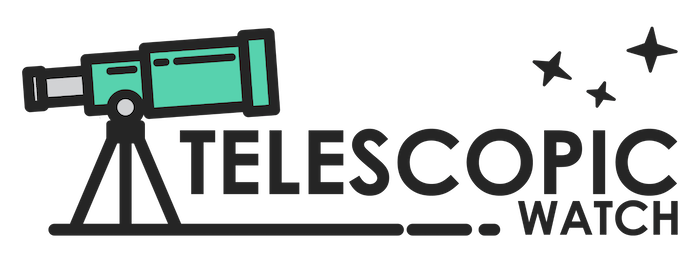Disclosure: If you buy something via our link, we may earn a commission with no additional expense to you. As an Amazon Associate, I earn from qualifying purchases. Learn more
Ranking All Tabletop Dobsonian Telescopes in the UK (76mm to 150mm)
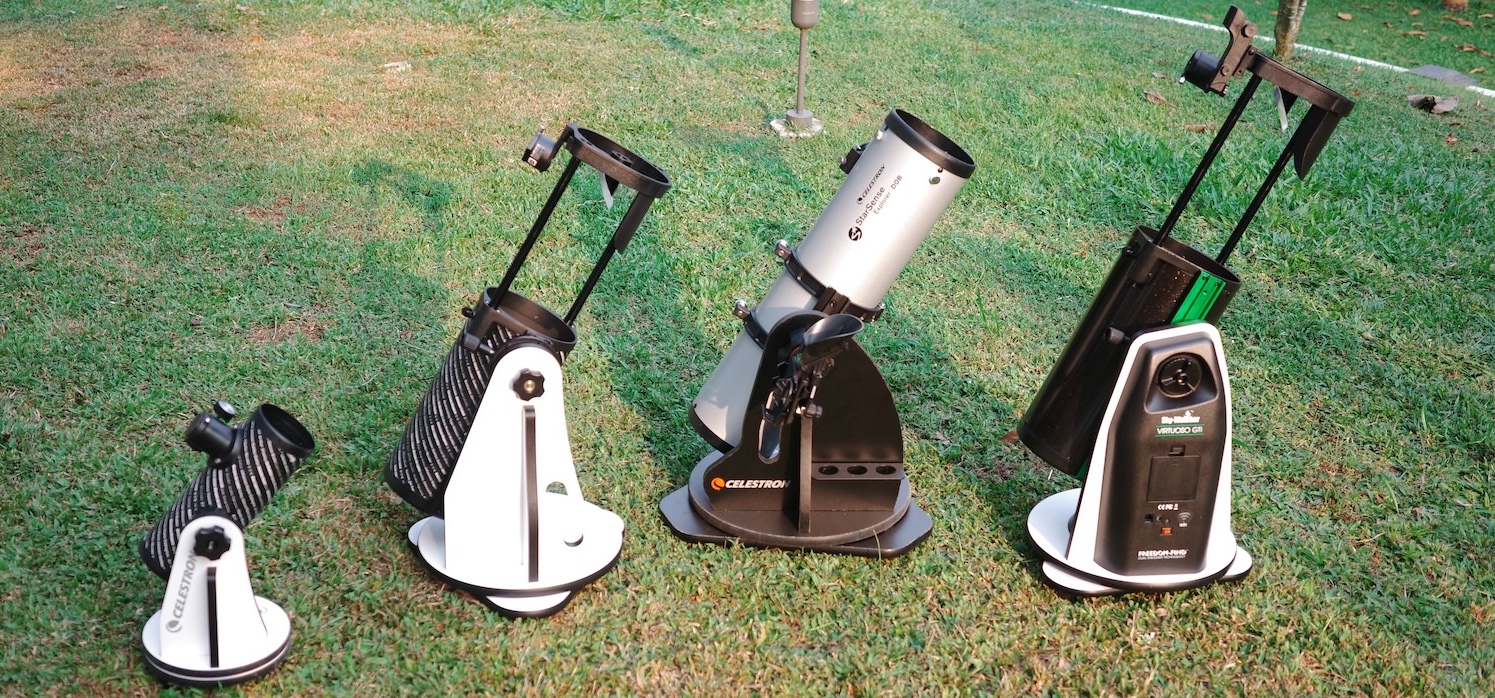
Tabletop Dobsonians in the 100mm-150mm aperture range are ideal for those who are tight on budget or storage space. They also make a superb complement to a larger telescope on those nights when we don’t feel like setting up the bigger one. Some people I know even have three Dobsonians or a combination of multiple telescopes to fulfil their different requirements. I’ve also had the luck to test out almost all tabletop telescopes available in the US in the last few years since I dealt with 400+ used and new telescopes—most of which are also sold in the UK.
- Planetary Imaging: This requires the largest telescope with tracking you can get your hands on. If equipped with tracking, Dobsonians are also superb planetary imaging telescopes. I recommend you head to our Computerised Telescopes Ranking Page for such scopes.
- Deep Sky Astrophotography: This requires a budget well in excess of £1000 and typically involves purchasing a separate optical tube assembly and computerised equatorial mount rather than the mostly-visual-focused all-in-one telescopes.
- If you’re looking for larger aperture telescopes, we have a page dedicated to full-sized dobsonians.
Rank Category: 76mm Tabletop Dobsonians
The 76mm tabletop Dobsonians are all f/4 focal ratio units with spherical mirrors that are unsurprisingly incapable of rendering sharp images. Their inherent wide field of view makes aiming with it easy, provided the eyepieces provided are also up to snuff. But even then, don’t expect high-resolution views. However, if it’s all you can afford, the tabletop Dobsonians still beat having nothing. Performance is roughly equal to a good pair of astronomy binoculars, which we would probably recommend instead if you are on a very tight budget.
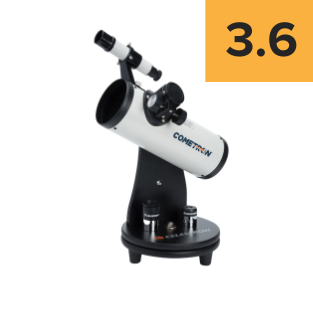
While not particularly useful overall, the Celestron FirstScope’s Cometron version offers a super-cheap introduction to the world of telescopes in a diminutive package. It’s not a serious observation tool by any means. The views through this instrument at even low powers are mushy, and the eyepieces feel like looking through a drinking straw.
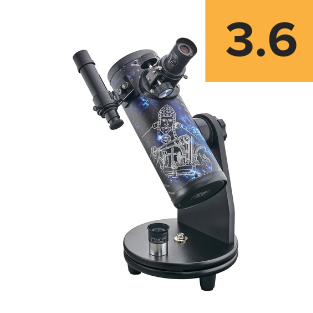
Skywatcher Heritage 76 Mini Dobsonian Telescope
Identical to the Celestron FirstScope Cometron edition, the Sky-Watcher Heritage 76 features a low-quality finderscope and shoddy optics but is equally easy to use and provides acceptable low-power views of the Moon and other easy targets with its provided eyepieces.
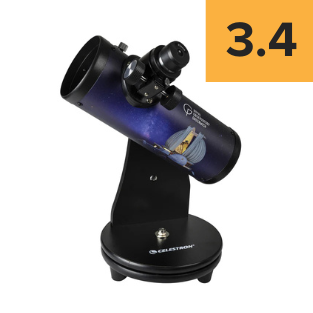
The basic bare-bones FirstScope will work okay, but it lacks a finder or acceptable quality eyepieces. The Moon version is identical to the basic Celestron FirstScope but with a different optical tube decoration.
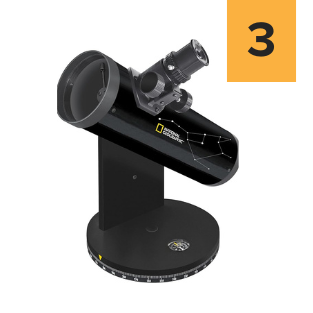
National Geographic 76 Tabletop Dobsonian
Little more than a rebadged FirstScope with low-quality Huygens eyepieces and a higher price, the NatGeo 76mm is a poor deal when you can get FirstScope versions that come with better-quality accessories (though the same flawed optics) at its price range.
Rank Category: 100mm Tabletop Dobsonians
Most 100mm tabletop Dobsonians have parabolic primary mirrors for sharp images, though they often lack collimation adjustment for the primary mirror, which can lead to sub-par performance. They’re also capable of being mated to photo tripods for on-the-go use. Upgrading to nicer accessories with any of these scopes places you in a higher price bracket where there are better options. As such, it’s still worth considering binoculars or saving your money for a bigger scope if this is all you have to spend right now.
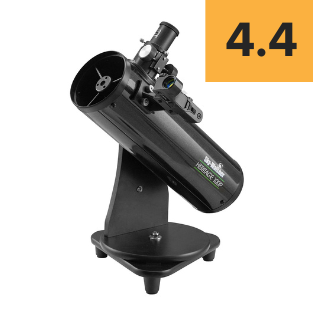
Sky-Watcher’s Heritage 100P is one of few Newtonian reflectors—or telescopes at all—sold with quality optics, a sturdy mount, and acceptable accessories sold at such a low price range. You get an ample 100mm aperture, a set of nice eyepieces, a red dot finder, and a very easy-to-use and lightweight tabletop Dobsonian mount. It’s also extremely portable, fitting into even a moderately sized backpack.
Rank Category: 114mm Tabletop Dobsonians
114mm tabletop Dobsonians are just a hair bigger than their smaller 100mm counterparts but offer a 30% gain in light-gathering ability and a 14% gain in resolving power, with the ability to adjust collimation provisioned for as well. Generally, these scopes are also subject to a higher level of quality control than more inexpensive options when it comes to optical and build quality as well.
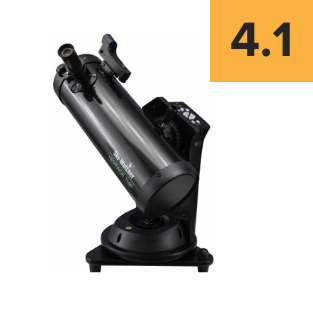
Skywatcher Heritage 114P Virtuoso
The Sky-Watcher Heritage 114P provides a ubiquitous 114 mm f/4.4 Newtonian reflector optical tube atop the Virtuoso auto-tracking mount (not to be confused with the superior Virtuoso GTi mount). This Virtuoso mount will automatically track the sky for you after a very simple alignment process (just point it north at the horizon and turn it on) and has push-button fine-pointing adjustments.
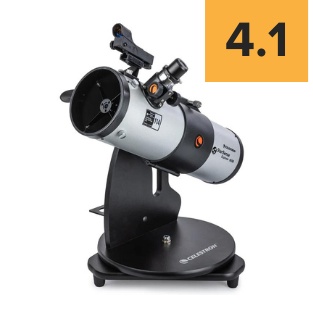
Being a tabletop Dobsonian reflector with a 114mm high-quality primary mirror that’s easy to collimate, a simple Dobsonian mount, and quality accessories, the Celestron StarSense Explorer 114mm Dobsonian is great for looking at the deep sky due to its inherent wide field of view and returns okay results with planets as well. It is capable but is a pricey pick. You could get a 130mm tabletop Dobsonian for the money. The StarSense Explorer technology is very helpful in locating targets, though.
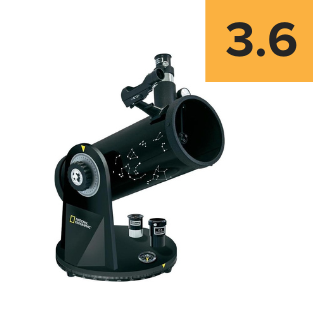
National Geographic 114 Tabletop Dobsonian
The National Geographic 114mm Tabletop Dobsonian offers decent optics but comes with toy-like Huygens eyepieces, which will cost quite a bit to replace with acceptable quality ones, and any telescope requires good eyepieces to deliver a pleasing view.
Rank Category: 130mm (5″) Tabletop Dobsonians
A 130mm telescope gives you another 30% gain in light-collecting power over a 114mm and is still extremely portable and easy to set up. The longer focal ratios of most of these scopes also make them more forgiving of cheap eyepieces like the ones provided with these telescopes, as well as laxer collimation tolerances. 130mm of aperture, enough to see plenty of faint deep-sky objects from a suitably dark location and resolve fantastic detail on the Moon and planets.
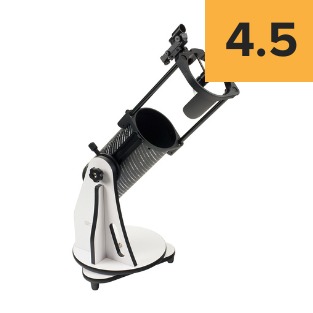
The Heritage 130P includes a pair of great eyepieces, high-quality optics with a parabolic primary mirror, and a collimation tool and also features a collapsable tube that allows it to fit into a smaller space. This collapsable tube feature does create the disadvantage of stray light being able to easily enter the tube, which can be (mostly) remedied by creating a foam shroud. However, we believe that the compactness and light weight are more than worth this minor inconvenience.
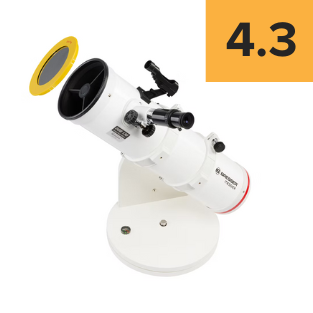
The Bresser Messier 5″ tabletop Dobsonian features a high-quality parabolic primary mirror, an acceptable set of accessories, and a simple tabletop Dobsonian mount with rotating rings to adjust the angle of the eyepiece. However, it is not as lightweight or compact as the Heritage 130P, nor are its accessories quite as up to par.

The Celestron StarSense Explorer 130mm Dobsonian has optics similar to the Sky-Watcher Heritage 130P but adds tube rings—eliminating the need for a light shroud—and a nicer focuser. Its major difference is the inclusion of Celestron’s StarSense Explorer technology, which helps you locate objects using your smartphone, though it does not track them. However, at the price Celestron is asking, there are better computerised tabletop options even in the 150mm aperture.
Rank Category: 150mm Tabletop Dobsonians
A 150mm tabletop Dobsonian is great for those who need an ultra-portable scope with a decent aperture, but it will really need a custom support or a permanent solid surface, not a table. You get a lot more portability compared to freestanding 6” (150mm) f/8 Dobsonians, and the faster f/5 focal ratio of these tabletop scopes allows them to achieve a similar field of view to even a 6” f/8 freestanding dobsonian equipped with a 2” focuser.
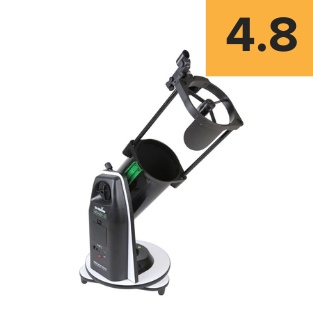
The Sky-Watcher Virtuoso GTi 150P is a fully computerised 150mm tabletop dobsonian telescope in a compact, lightweight package. It features quality optics, well-made included eyepieces, and the ability to be used manually even while the mount’s electronics are powered on and aligned with the sky. At its price, it’s hard to argue against this excellent instrument—remarkably, it costs about the same as a manual-only 6-inch telescope. After the StellaLyra 8″ freestanding Dobsonian, among our beginner readers, it ranks as the second most popular choice.
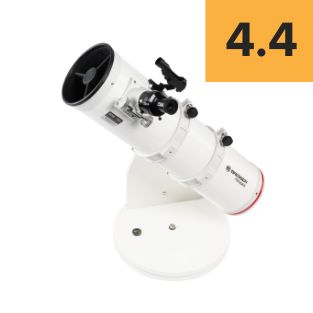
The Bresser Messier 6″ Tabletop Dobsonian is an excellent choice for those who must have a closed-tube 150mm tabletop scope and delivers a huge achievable field of view with its 2” focuser and short 750mm focal length if used in conjunction with the right wide-angle eyepieces.
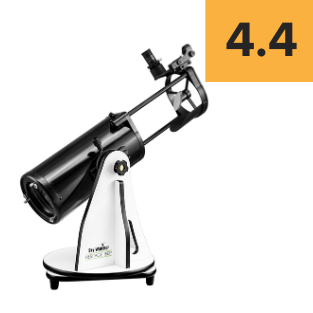
The SkyWatcher Heritage 150P is the non-computerised version of the SkyWatcher Virtuoso GTi 150P, with no other significant differences. The requirements, compromises, and benefits are all the same, except for the absence of the computerised system. Compared to the Bresser Messier tabletop, the Heritage 150P has a less capable 1.25″ focuser and requires a shroud to work properly, but it does come at a far lower price.
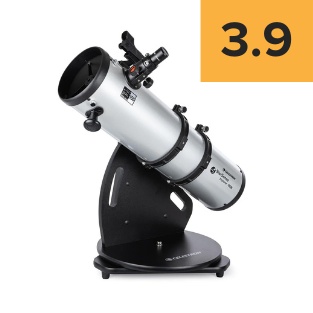
Celestron StarSense Explorer 150mm Dobsonian
The Celestron StarSense Explorer 150mm Dobsonian uses standard 150mm f/5 optics similar to the SkyWatcher Heritage/Virtuoso 150 tabletops and has a similar single-armed tabletop base. Considering that the similar-optic, fully computerised Virtuoso GTi 150P is quite a bit less expensive, we can’t really think of a good reason to go with the StarSense Explorer 150mm Dobsonian over the dozen picks ahead of it, though it certainly delivers excellent views and is aided by the easy-to-use StarSense Explorer smartphone app and technology.
